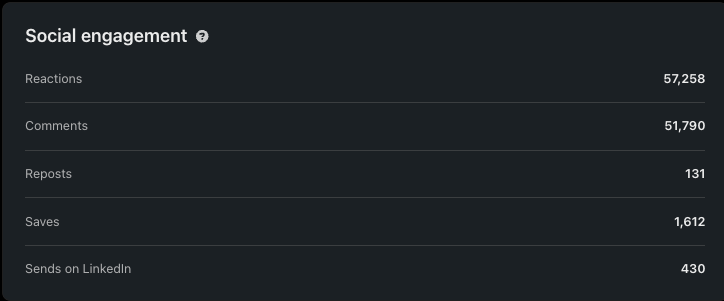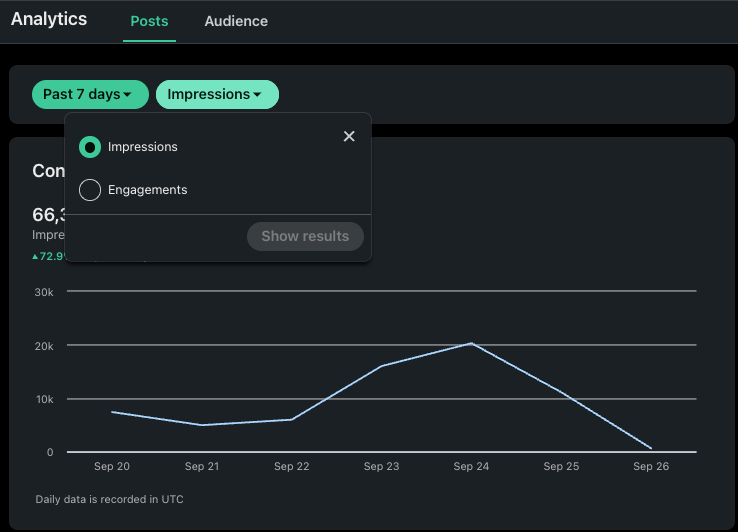What is up with Linkedin's algorithm?!
How the world's oldest social network is evolving for the AI-era.
Hello & Happy Friday, my Friends!
I hope you’ve had a spectacular week and have a wonderful weekend.
First things first, I’d like to get your opinion on something. I keep feeling pulled to change the name of this newsletter to “Humans&Robots” because I find myself essentially splitting my time between the two as of late.
I live on Linkedin building relationships with other humans pretty much anytime I’m not at the gym, with clients, or with my family. That’s a lot of hours per day. And being that I’m on Linkedin all the time, I’m bound to start seeing more and more content that I tell Linkedin I like seeing. As you can imagine, AI is a big part of that.
The current name for this newsletter stands for Friends of Liam Darmody, which I love and plan to use as the name for the community I eventually launch (you heard it here first!), but this particular newsletter feels like a blend of content about humans & tech, so that’s why Humans&Robots resonates. It’s also a better descriptor of what’s inside the newsletter than The FoLD, so that’s another reason I like it.
I’m curious…
Thanks in advance for your $.02, it does mean a lot to me.
Onto this week’s fascinations…
Linkedin announced some new metrics to analytics last week and I’m pretty excited about: Saves & Sends. These features have long been a part of Linkedin, but it’s never been something we could track. It’s also not really something many people talk about on Linkedin. You see people asking others to repost things all the time, but it’s never “Save & Send this post if you found it useful.”
So imagine my surprise when I looked at my engagement analytics and realized that my content since August 2024 has been saved 12.3x & sent 3x as many times as it’s been reposted.
So what, you ask?
Well, according to ChatGPT:
I’m also pumped because I’m much more comfortable nudging my audience to save and/or send my post to someone than I am asking them to repost it. Something about the latter just rubs me the wrong way for some reason—like I’m trying to just collect more impressions. I trust that if they want to repost it, they will, and that’s an honor best received unprompted. This is why you never really see me make that ask.
But asking them to save or send? I’m going to start doing that for sure because I’m not really asking that much from them and the qualitative data that provides me about my posts will help me better understand what my audience likes to consume.
That’s the purpose of metrics: what gets measured, gets better. To me, someone saving or sending my content is probably the strongest interest signals I could receive. If only Linkedin would tell us who it was…
If you’d like to check yours out, go to your analytics and toggle impressions to engagements. You can look back a little over a year selecting “custom” date ranges.
Speaking of useful analytics, ever since Linkedin started showing us how many premium custom button engagements & link clicks we get, I’ve started including links in the CTA at the bottom of my posts a lot more frequently—one to this newsletter & one to download my free Linkedin profile scorecard from my Stan Store, which also has some of my other digital offerings
“But Liam, doesn’t including links in posts decrease reach?”
Anecdotally, yes, most of my posts containing links do get less impressions than those without them, but they also get more link clicks (duh!) and all it takes is one link click to land new business, so I’m confident that if I keep the quality of my content high, and I am diligent about adding new people to my network each week who might benefit from it, I might get that magic click or two.
Or 519…
I also believe that the fact that Linkedin is making this data available to us shows that they do want us to use links in our posts, because if they didn’t, why would they build a metric for it in our analytics?
The shifts we’re seeing on Linkedin right now are massive.
The algorithms have been overhauled completely and I believe that AI is now running the distribution show, not the engagement we receive. And that checks out for me in my content—I have some posts with hundreds of engagements and 1/4th the distribution of a post with dozens of engagements, leading me to believe that engagement contributes less to post distribution now than it ever has.
The days of dropping a random poll and getting 6,000 votes and 40,000 impressions are over on Linkedin, and I think it’s because they’ve developed a much more robust AI to determine what content to show to whom and how far it will spread on platform.
And I’m not the only one…
Yesterday I stumbled upon this post by Christopher Penn, co-founder & chief data scientist at Trust Insights, which compiled this 67-page report about the latest changes to the algorithm after analyzing the latest technical papers, blog posts, and data from Linkedin Engineering. This isn’t your average algorithm report created by someone trying to sell you Linkedin coaching services. This seems a lot more expert than that…
From Chris’s post:
The big news is that not only has the system changed since our last version of the paper (back in May), it’s changed MASSIVELY. It behaves very differently now because there’s all new technology under the hood that’s very clever but focuses much more heavily on relevance than recency, courtesy of a custom-tuned LLM under the hood.
While it’s not verified by anyone at Linkedin (that would never happen, obviously), it does support my current hypothesis, which is that a very advanced AI is now determining reach rather than the amount of engagement a post gets.
This is a drastic departure from what we’re used to, which is trying to get as much engagement within the first hour of a post going live to ensure Linkedin views the post as valuable and gives it more distribution.
No wonder we’re seeing all the gurus complaining—their engagement pods aren’t working anymore (good riddance!)
I’m halfway through the report and the gears in my head are spinning faster than ever. I’ll summarize it next week when I’m done, but the key takeaways for me so far are that quality matters more than quantity now. Remember, Linkedin prides itself on being an editorially-focused company, so they want to see high quality content & conversation happening across the platform.
Essentially, they’re training (forcing?) us to stop writing for the algorithm, and focus on writing quality content and trusting that Linkedin will distribute it to the people who are most likely to want to see it & engage with it.
To be sure, there will be many skeptics, but I am not one—as I always say, it’s still early days for the world’s oldest social network.
Other Linkedin posts that caught my eye this week:
Gamma.ai launched it’s Gamma Agent: your AI design partner to help you make beautiful presentations in seconds. Gamma is already one of my favorite tools, but this takes it to the next level. Be sure to watch the video…
Gary Vaynerchuk invested in popular creator marketing platform Stan and launched the GaryVee x Stan challenge. For $200 you get access to 8 sessions with Gary Vaynerchuk about how to build your creator brand.
Lakshman Somasundaram, Sr. Director of Product for Video & Games at Linkedin shared some insights about how video is working on platform right now.
Nicholas Thompson, CEO of The Atlantic, shared some thoughts about a new study that reveals pretty surprising & concerning patterns in the AI-human relationship—a reminder that as much as AI helps us, there is still a very real risk that some people just aren’t ready to use it as a robot and instead getting too cozy with it.
In the same vein, Erran Berger, VP of Product Engineering at Linkedin, shared a really great article by Derek Thompson entitled “The End of Thinking” about how AI is making us lazy brained. It’ll make you want to step away from your computer and go touch grass.
There’s so much more I could talk about, but I’m pooped, and if you’ve made it this far, I bet you are, too. So thank you for reading and if you enjoyed it, I hope you’ll save or send it to someone! (get used to making that ask, it’s worth it!)
Hi5,
LD
🌶️








I’m in favor of the new name. And did I hear “community”?????
I personally like your original newsletter name, Liam. I think The FoLD can also reference the space between humans and robots and how these two sides come together. 😁